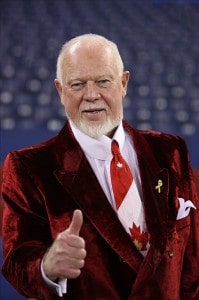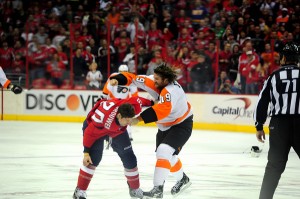Twenty-six seconds into a game between Ottawa and Toronto, a hockey fight occurred (warning, this video may disturb some viewers).
I’ve been watching hockey for close to 40 years. Growing up, players like Terry O’Reilly and Hammer Schultz were as well known as Guy Lafleur and Marcel Dionne. I’ve watched Tiger Williams and Tie Domi live, and seen the entire careers of Bob Probert, Chris Nilan and Marty McSorley.
Following the fight in the above video, a friend posted to Facebook that it made him feel ill watching. This is a guy who plays men’s league. He was never a scrapper or anything, but I have known him a long time, watched hundreds of games with him. He’s never been the squeamish kind.
I’m not a dinosaur, a neanderthal, a cretin. I see merit in the arguments to eliminate fighting, and in the arguments to maintain the rules as they are. The team I grew up watching has always employed players who could fight… guys like Williams and Domi were among the best of them, and we – my friends and other fans we watched games with – cheered those players enthusiastically. But I’ve been thinking about the issue… and the struggle when you really don’t fall in one camp or the other.
Fighting History
Look, on the ‘pro-fighting’ side, I cannot deny certain truths. Hockey has a long history of on-ice violence. I’m currently reading the story of Eddie Shore, and the descriptions of the kind of tooth-smashing stickwork and nose-crushing fisticuffs make today’s fights seem like kids arguing over who gets the last cookie. Frankly, though many have decried the violence of hockey, the paying customers have always seemed to love it. It wasn’t that long ago that ‘Penalty Minutes Leaders’ were featured on hockey cards along side ‘Most Goals’ and ‘Most Points’. Players who could ‘take care of themselves’, whether they were stars like Shore or Gordie Howe or Jarome Iginla, or just fourth-line pluggers, have tended to be admired by the faithful.

Toughness, from Conn Smythe’s Maple Leafs, or the Big Bad Bruins and Broad Street Bullies of the 1970s, has been prized. Not just the mental toughness to overcome obstacles, but physical toughness… taking and giving hits, and ultimately, intimidating and fighting your opponent until you win. Generally, it’s been successful. Many of the great teams had guys named Cleghorn and Shore, and Ferguson, Gillies and Semenko and a host of others along the way.
Fighting Popularity
It is a part of the game’s history, and part of the spectacle. To go back to my friend’s Facebook post, he went on to say that while seeing David Dziurzynski knocked out stunned and shocked the crowd at the ACC, the same incident would be cheered lustily at any Mixed Martial Arts or Ultimate Fighting match. While boxing may wane in popularity, MMA/UFC cards seem to be only gaining momentum (for the record, it’s been over 15 years since I watched a pro boxing match, and I have never been a fan of MMA).
MMA is not hockey, nor should the NHL find ways to increase violence in its game. But, there is an argument that fighting has been a part of hockey for decades, that violent sports do prove to be popular and have fanbases that can grow rapidly. And while there’s no direct correlation found, interestingly NHL attendance is up about 2% over last season, and fighting in the NHL is also up this year (though the previous trend seemed to be downward).
Fighting Perception
“The NHL should not allow fighting” is a phrase that gets thrown out into the discussion. I’ve always wondered about that. The NHL doesn’t allow slashing, or tripping, or hooking – these actions are not allowed but they happen, and they are punished when detected by a prescribed penalty. Similarly, fighting is not ‘allowed’ – there are rules and punishments in place to deal with it.
Fighting occurs in hockey more often than in other sports, but it exists in other sports, despite the assertion that it’s banned. One recent example occurred days after the Ottawa-Toronto game cited above:
http://www.youtube.com/watch?v=bWLLdoWPyPk
Note, no further suspensions were handed down following this baseball game, in a sport that doesn’t allow fighting.
Okay, so maybe people are really just asking for stiffer penalties on fighting. Predictably, Ken Campbell of The Hockey News lamented the fight, and suggested that perhaps game misconducts would have deterred the combatants from fighting. Funny thing is, the NHL has stiff penalties for things like checking from behind, high-sticking when blood is drawn, illegal checks to the head, and these kinds of infractions still occur. Yes, they occur less often, but if stiff penalties were really a 100% effective deterrent, there wouldn’t have been a murder in the world for centuries now – the threat of penalty would have prevented them.
Fighting the Status Quo
And yet, even as someone who has defended fighting in hockey, I find it more difficult to do so.
Certainly, as the McLaren-Dziurzynski bout shows, people can be seriously injured in a hockey fight. Though Nick Kypreos remains a proponent of fighting, one cannot forget his career was ended as a direct result of a preseason fight.
While I do see the merits in spontaneous bouts, and I acknowledge how a guy like Dave Semenko riding shotgun for Wayne Gretzky can help reduce the liberties opposing players may take with stars, I am similarly not a fan of staged fights, nor do I buy the “momentum” defense.
Staged fights simply fly in the face of one of the arguments that is supposed to justify fighting in the game – that the speed and emotion of the game builds up and fighting provides both an effective release valve as well as a system of self-policing against ‘bad behaviour’. Staged fights, especially one 26 seconds into a game, between 2 players who have little to no history of previous conflict, is simply an act. It has no basis in ’emotion’ and no genesis in the flow of the game, no root in ‘old scores to settle’.

As for momentum, well, there seems to be more anecdotal than statistical evidence that fighting significantly helps a team, or rather helps one team over another. Some studies show it may take as many as 30, 60 or even 80 fights a year to gain a single win more in a season. But since one player from each team fights, and so many fights are close wins or draws, how can one know which of the teams gets the momentum swing? If one team is carrying momentum when the fight occurs, and they maintain it, was the fight even necessary?
And, speaking of necessity, I find I question the value of designated fighters. Nothing personal, but it’s hardly a secret some of these guys, often referred to as ‘goons’, might see 3 minutes worth of ice time, and do little but look for trouble. In Toronto, some question current coach Randy Carlyle’s use of guys like Frazer McLaren and Colton Orr for upwards of 10 minutes or more (though luckily for Carlyle, the Leafs actually managed to win games while these guys were playing). Sure, there are some players who combine skill, size and an ability, even propensity, for fisticuffs. But there’s still jobs for designated enforcers, and when those players are engaging in staged fights, what really is the value of that?
Fighting Both Sides
So, ultimately, where do I come down in this battle? I’m not sure. In the mid 1970s, the Philadelphia Flyers were the toughest team out there, and as a Maple Leaf fan, I loved when my team could match them goal for goal, save for save and at times punch for punch. But I see how that era shifted the focus to stocking up on guys who could intimidate with fists rather than with speed and scoring.
People s they would like to surveyed say they’d like fighting banned, and though many call for the elimination of fighting in the name of safety, many of the players themselves do no see it that way. Further, the justification to eliminate fighting based on the injury factor, despite players accepting the risks, can be a slippery slope. Bodychecking, shot blocking, any incidental contact caused by players skating at speed, has the potential to inflict injury, even serious injury. Are we prepared to ban anything that could cause injury?
Sometimes, fights are going to happen. I’ve heard the argument made that “I can’t just go fight someone on the street, that’s not allowed in real life so it shouldn’t be allowed in hockey.” True, but you can’t bodycheck or otherwise physically assault people in ‘real life’, unlike what occurs in sport – it’s simply not a parallel. The ice surface is not your office, not a public space. The game itself operates under rules different from the workplace of most people.
It may be unpopular, but ideally, I’d like to see fighting remain. I don’t dismiss the chances people will be hurt, but that risk exists just by stepping onto the ice. I’d like to see players have a thicker skin. It’s a physical game, not every hit is a reason to challenge someone to a fight. I’d prefer to see skilled players who are tough in their own right, and I’d prefer to see the staged fight and the designated goon eliminated.
But I also know that may no longer be possible.